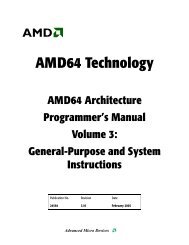Using TCP Through Sockets
Using TCP Through Sockets
Using TCP Through Sockets
Create successful ePaper yourself
Turn your PDF publications into a flip-book with our unique Google optimized e-Paper software.
general, a client wishing to create a <strong>TCP</strong> connection to a server first calls socket to create<br />
a socket, optionally calls bind to specify a local address, and finally connects to the server<br />
using the connect system call.<br />
The function tcpconnect shows all the steps necessary to connect to a <strong>TCP</strong> server. It<br />
makes the following system calls:<br />
• int socket (int domain, int type, int protocol);<br />
The socket system call creates a new socket, just as open creates a new file descriptor.<br />
socket returns a non-negative file descriptor number on success, or −1 on an error.<br />
When creating a <strong>TCP</strong> socket, domain should be AF INET, signifying an IP socket, and<br />
type should be SOCK STREAM, signifying a reliable stream. Since the reliable stream<br />
protocol for IP is <strong>TCP</strong>, the first two arguments already effectively specify <strong>TCP</strong>. Thus,<br />
the third argument can be left 0, letting the Operating System assign a default protocol<br />
(which will be IPPROTO <strong>TCP</strong>).<br />
Unlike file descriptors returned by open, you can’t immediately read and write data to<br />
a socket returned by socket. You must first assign the socket a local IP address and<br />
port number, and in the case of <strong>TCP</strong> you need to connect the other end of the socket<br />
to a remote machine. The bind and connect system calls accomplish these tasks.<br />
• int bind (int s, struct sockaddr *addr, int addrlen);<br />
bind sets the local address and port number of a socket. s is the file descriptor number<br />
of a socket. For IP sockets, addr must be a structure of type sockaddr in, usually<br />
as follows (in /usr/include/netinet/in.h). addrlen must be the size of struct<br />
sockaddr in (or whichever structure one is using).<br />
struct in_addr {<br />
u_int32_t s_addr;<br />
};<br />
struct sockaddr_in {<br />
short sin_family;<br />
u_short sin_port;<br />
struct in_addr sin_addr;<br />
char sin_zero[8];<br />
};<br />
Different versions of Unix may have slightly different structures. However, all will have<br />
the fields sin family, sin port, and sin addr. All other fields should be set to zero.<br />
Thus, before using a struct sockaddr in, you must call bzero on it, as is done in<br />
tcpconnect. Once a struct sockaddr in has been zeroed, the sin family field must<br />
be set to the valueAF INET to indicate that this is indeed asockaddr in. (Bind cannot<br />
take this for granted, as its argument is a more generic struct sockaddr *.)<br />
5
















